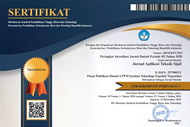Penilaian Risiko Banjir dengan Pendekatan Rasio Frekuensi dan AHP di Sub-DAS Jompo, Jember Jawa Timur
Abstract
Keywords
Full Text:
PDFReferences
J. H. Danumah et al., “Flood risk assessment and mapping in Abidjan district using multi-criteria analysis (AHP) model and geoinformation techniques, (cote d’ivoire),” Geoenvironmental Disasters, vol. 3, no. 1, 2016, doi: 10.1186/s40677-016-0044-y.
J. Ryu, E. J. Yoon, C. Park, D. K. Lee, and S. W. Jeon, “A flood risk assessment model for companies and criteria for governmental decision-making to minimize hazards,” Sustain., vol. 9, no. 11, 2017, doi: 10.3390/su9112005.
A. K. Gain, V. Mojtahed, C. Biscaro, S. Balbi, and C. Giupponi, “An integrated approach of flood risk assessment in the eastern part of Dhaka City,” Nat. Hazards, vol. 79, no. 3, pp. 1499–1530, 2015, doi: 10.1007/s11069-015-1911-7.
A. K. Gain, C. Giupponi, and F. G. Renaud, “Climate change adaptation and vulnerability assessment of water resources systems in developing countries: A generalized framework and a feasibility study in Bangladesh,” Water (Switzerland), vol. 4, no. 2, pp. 345–366, 2012, doi: 10.3390/w4020345.
S. Liao and J. Sun, “GIS Based Spatialization of Population Census Datain Qinghai-Tibet Plateau,” ACTA Geogr. Sin. Ed., vol. 58, no. 1, pp. 25–33, 2003.
Z. Banoo, A. Amineh, S. Jamal, A. Hashemian, and A. Magholi, “Integrating Spatial Multi Criteria Decision Making ( SMCDM ) with Geographic Information Systems ( GIS ) for delineation of the most suitable areas for aquifer storage and recovery ( ASR ),” J. Hydrol., 2017, doi: 10.1016/j.jhydrol.2017.05.031.
L. Region, Y. Wang, Z. Li, and Z. Tang, “A GIS-Based Spatial Multi-Criteria Approach for Flood Risk Assessment in the Dongting,” pp. 3465–3484, 2011, doi: 10.1007/s11269-011-9866-2.
A. M. A. Shamsuddin and S. Ali, “A GIS-based integration of catastrophe theory and analytical hierarchy process for mapping flood susceptibility : a case study of Teeb area , Southern Iraq,” Environ. Earth Sci., 2016, doi: 10.1007/s12665-016-5523-7.
C. Lai, X. Chen, X. Chen, and Z. Wang, “A fuzzy comprehensive evaluation model for flood risk based on the combination weight of game theory,” pp. 1243–1259, 2015, doi: 10.1007/s11069-015-1645-6.
F. Zeng, C. Lai, and Z. Wang, “Flood Risk Assessment Based on Principal Component Analysis for Dongjiang River Basin,” 2012.
Q. Zou, J. Zhou, and C. Zhou, “Comprehensive flood risk assessment based on set pair analysis-variable fuzzy sets model and fuzzy AHP,” pp. 525–546, 2013, doi: 10.1007/s00477-012-0598-5.
C. Cao, P. Xu, Y. Wang, J. Chen, L. Zheng, and C. Niu, “Flash flood hazard susceptibility mapping using frequency ratio and statistical index methods in coalmine subsidence areas,” Sustain., vol. 8, no. 9, 2016, doi: 10.3390/su8090948.
H. Nasiri, M. J. M. Yusof, T. A. M. Ali, and M. K. B. Hussein, “District flood vulnerability index: urban decision-making tool,” Int. J. Environ. Sci. Technol., vol. 16, no. 5, pp. 2249–2258, 2019, doi: 10.1007/s13762-018-1797-5.
H. Apel, G. T. Aronica, H. Kreibich, and A. H. Thieken, “Flood risk analyses - How detailed do we need to be?,” Nat. Hazards, vol. 49, no. 1, pp. 79–98, 2009, doi: 10.1007/s11069-008-9277-8.
T. L. Saaty, “How to make a decision: the analytic hierarchy process,” Eur. J. Oper. Res., 1990, doi: 10.1016/0377-2217(90)90057-I.
S. Hu, X. Cheng, D. Zhou, and H. Zhang, “GIS-based flood risk assessment in suburban areas: a case study of the Fangshan District, Beijing,” Nat. Hazards, vol. 87, no. 3, pp. 1525–1543, 2017, doi: 10.1007/s11069-017-2828-0.
H. Shafizadeh-Moghadam, R. Valavi, H. Shahabi, K. Chapi, and A. Shirzadi, “Novel forecasting approaches using combination of machine learning and statistical models for flood susceptibility mapping,” J. Environ. Manage., vol. 217, pp. 1–11, 2018, doi: 10.1016/j.jenvman.2018.03.089.
Z. W. Kundzewicz, R. Konieczny, J. Zawiejska, and A. Radecki-pawlik, “Comprehensive approach to the reduction of river flood risk: Case study of the Upper Vistula Basin,” vol. 632, pp. 1251–1267, 2018, doi: 10.1016/j.scitotenv.2018.03.015.
Y. A. Wibowo, L. Ronggowulan, D. A. Arif, R. Afrizal, Y. Anwar, and A. Fathonah, “Perencanaan Mitigasi Bencana Banjir Non-Struktural Di Daerah Aliran Sungai Comal Hilir, Jawa Tengah,” JPIG (Jurnal Pendidik. dan Ilmu Geogr., vol. 4, no. 2, pp. 87–100, 2019, doi: 10.21067/jpig.v4i2.3632.
M. Rózycka, P. Migoń, and A. Michniewicz, “Topographic Wetness Index and Terrain Ruggedness Index in geomorphic characterisation of landslide terrains, on examples from the Sudetes, SW Poland,” Zeitschrift fur Geomorphol., vol. 61, no. 2014, pp. 61–80, 2017, doi: 10.1127/zfg_suppl/2016/0328.
W. J. Mononimbar, “PENANGANAN PERMUKIMAN RAWAN BANJIR DI BANTARAN SUNGAI, Studi Kasus: Permukiman Kuala Jengki di Kelurahan Komo Luar & Karame, Kota Manado,” J. Ilm. Media Eng., vol. 4, no. 1, pp. 26–31, 2014.
U. A. Sari, H. L. Yasri, and M. M. Arumawan, “Sosialisasi Mitigasi Bencana Banjir Melalui Pendidikan Kebencanaan Berbasis Kearifan Lokal,” JMM (Jurnal Masy. Mandiri), vol. 4, no. 4, pp. 3–7, 2020.
DOI: http://dx.doi.org/10.12962%2Fj2579-891X.v21i1.14670
Refbacks
- There are currently no refbacks.

Jurnal Aplikasi Teknik Sipil by Pusat Publikasi Ilmiah LPPM Institut Teknologi Sepuluh Nopember is licensed under a Creative Commons Attribution-ShareAlike 4.0 International License
Based on work at https://iptek.its.ac.id/index.php/jats




